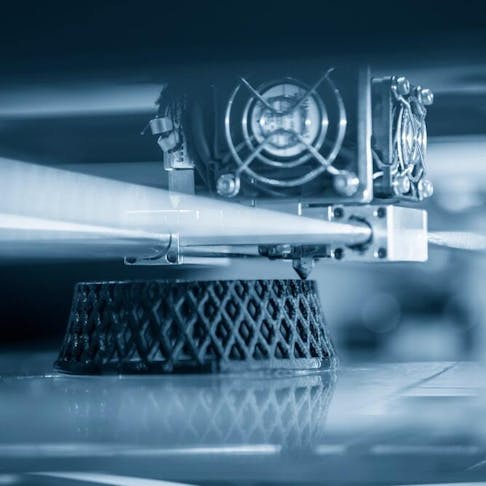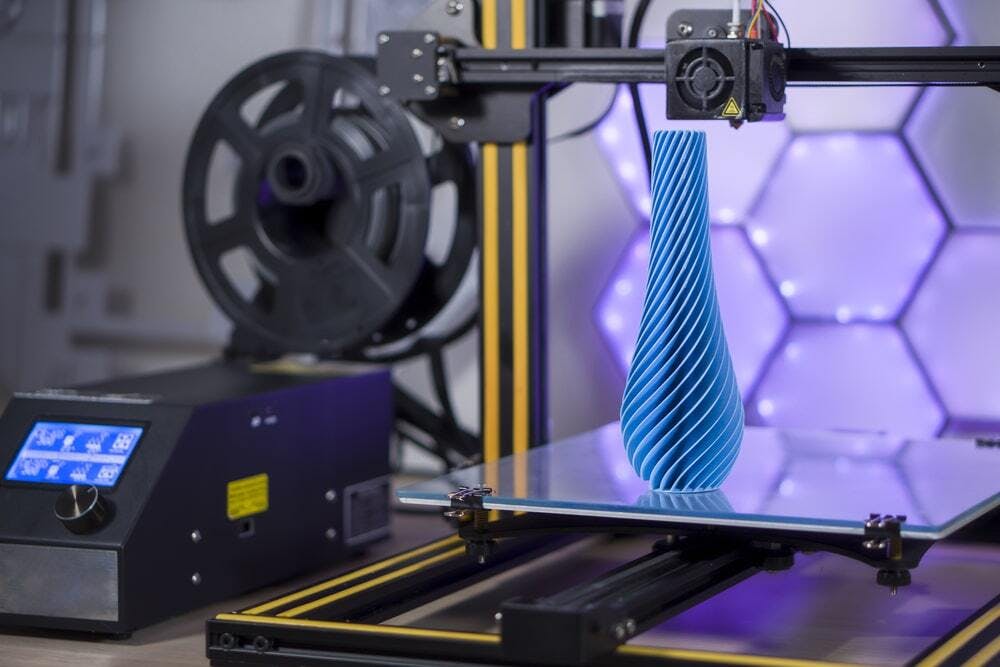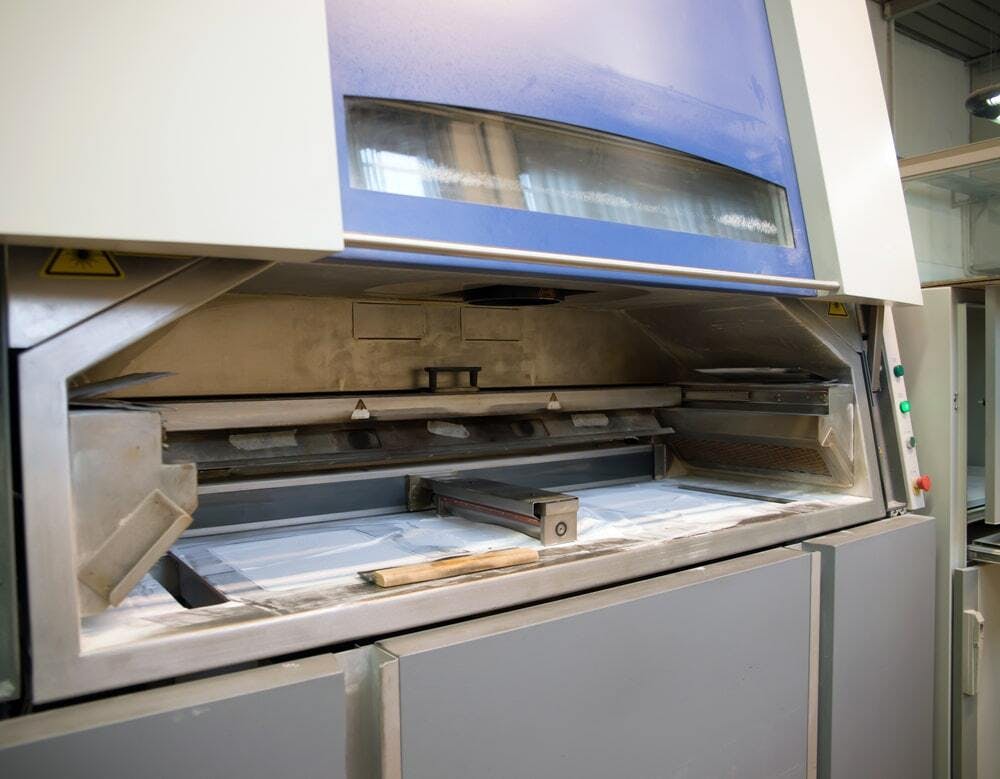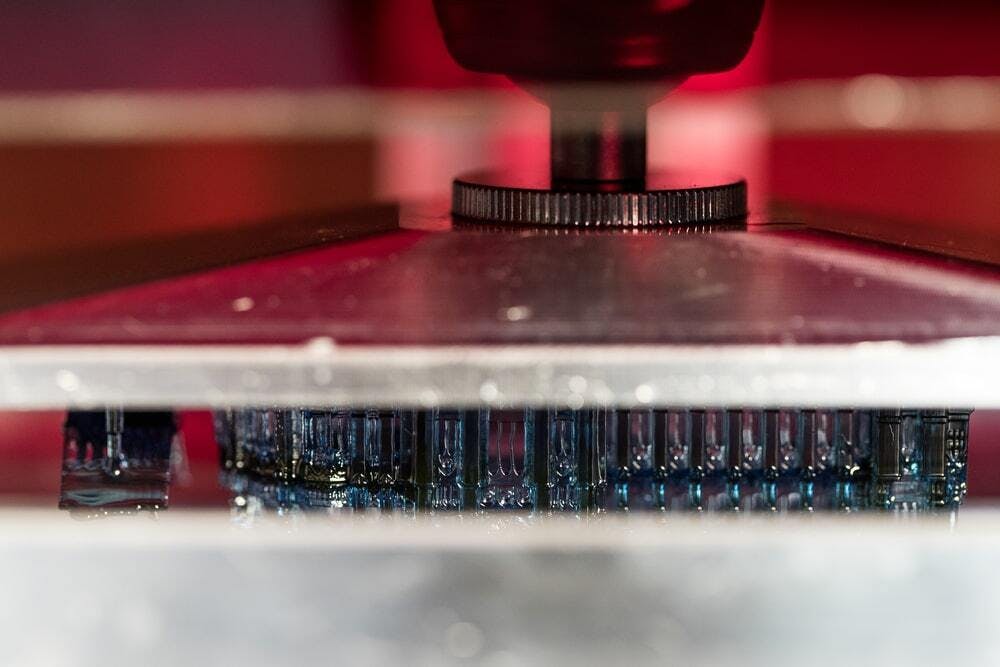
8 Types of 3D Printing Processes
Learn about these unique processes and how they differ from each other.
Since the first 3D printer was developed in the 1980s, 3D printing has become a term that describes a wide range of 3D printing technologies. Over the past few decades, 3D printing has matured into a well-established group of manufacturing technologies with many unique applications.
This article discusses the 3D printing types and will categorize them into eight distinct technology groups and describe their different processes.
1. Polyjet
The polyjet 3D printing process works very similarly to normal inkjet printing. The process consists of placing droplets of a photopolymer onto the build plate. A UV light then passes over this layer and solidifies it. The process repeats until the part is complete. Polyjet is highly accurate and very fast. It can also create multicolor and multi-material parts. The image below is a Polyjet printer:
Polyjet 3D printer.
Image Credit: Moreno Soppelsa/Shutterstock.com
The table below shows the advantages of Polyjet 3D printing:
| Materials | Strengths | Common Applications | Dimensional Accuracy |
|---|---|---|---|
Materials ABS, Simulated Polypropylene, Optically clear plastic | Strengths Accurate, Multi-Material, Biocompatible | Common Applications Soft Products, Overmolding | Dimensional Accuracy 0.1 to 0.3 mm |
Table 1. Polyjet 3D Printing Advantages
2. Fused Deposition Modeling (FDM)
Fused deposition modeling is one of the most well-known 3D printing types. It works by pushing a plastic filament through a heated nozzle. The molten plastic is then placed down layer by layer until the part is complete. There are many different 3D filament types available – from solid thermoplastics to flexible thermoplastic elastomers. The image below is an example of an FDM printer:
FDM 3D printing of blue glass ornament
Image Credit: Jose Barradas/Shutterstock.com
The table below shows the advantages of FDM 3D printing:
| Materials | Strengths | Common Applications | Dimensional Accuracy |
|---|---|---|---|
Materials ABS, PLA, ETG, Etc. | Strengths Cheap, Easy to operate | Common Applications Prototyping, Hobbyist parts, Manufacturing Jigs | Dimensional Accuracy 0.5 mm |
Table 2. FDM 3D Printing Advantages
3. Stereolithography (SLA)
Stereolithography was the first commercially available 3D printing technology. It works by curing a liquid photopolymer into the final part by tracing a high-powered laser in the shape of the part cross-section onto the build plate. This process continues while each subsequent layer is polymerized onto the previous one. The technology creates parts with extremely precise features. The image below shows an SLA printer:
Stereolithography DPL 3D printer.
Image Credit: asharkyu/Shutterstock.com
The table below shows the advantages of SLA 3D printing:
| Materials | Strengths | Common Applications | Dimensional Accuracy |
|---|---|---|---|
Materials Polycarbonate-Like, ABS-Like, Polypropylene like | Strengths High detail | Common Applications Casting patterns, Prototypes | Dimensional Accuracy 0.1 mm |
Table 3. SLA 3D Printing Advantages
4. Selective Laser Sintering (SLS)
Selective laser sintering works by placing down a layer of powdered plastic and tracing out the cross-section of the part with a laser. This laser melts the powder and fuses it. Another layer of plastic powder is laid over the previous one and the laser melts the cross-section shape while also fusing it into the previous layer. This process can produce highly accurate parts that can be printed in place provided there is an exit channel for unfused powder. The image below shows an SLS printer:
SLS 3D printer.
Image Credit: Moreno Soppelsa/Shutterstock.com
The table below shows the advantages of SLS 3D printing:
| Materials | Strengths | Common Applications | Dimensional Accuracy |
|---|---|---|---|
Materials Polyamide 12, Glass Filled Nylon | Strengths Isotropic materials, No support structures needed | Common Applications Flame retardant components, Medical devices | Dimensional Accuracy 0.3 mm |
Table 4. SLS 3D Printing Advantages
5. Direct Metal Laser Sintering (DMLS)
Direct metal laser sintering is a process used to manufacture metal parts. The process works by placing down a thin layer of powdered metal. A high-power laser then traces out the cross-section of the part and sinters the metal powder together. After each layer is complete, another layer of powder is deposited and the process is repeated. It must be noted that sintering is not the same as melting. The metal powder is only fused on the surface. The image below is of a DMLS printer:
3D printing metal on laser sintering machine.
Image Credit: MarinaGrigorivna/Shutterstock.com
The table below shows the advantages of DMLS 3D printing:
| Materials | Strengths | Common Applications | Dimensional Accuracy |
|---|---|---|---|
Materials Stainless Steel, Aluminum, Nickel Alloys, Titanium | Strengths High-strength metal parts | Common Applications Aerospace & automotive components | Dimensional Accuracy 0.1 mm |
Table 5. DMLS 3D Printing Advantages
FREE SLA 3D Printing Design Guide
6. Electron Beam Melting (EBM)
Electron beam melting is one of the more advanced 3D printing techniques that use an electron beam to fuse metal particles. The process works by depositing a thin layer of metal powder. An electron beam then traces out the cross-section. The beam can be split to melt multiple areas at once, significantly improving production speed. This high-energy beam melts the particles together creating a homogeneous microstructure that results in high-strength parts. The build chamber must be kept under a vacuum for the beam to work correctly. The image below is that of an EBM printer:
EBM 3D printer.
Image Credit: Moreno Soppelsa/Shutterstock.com
The table below shows the advantages of EBM 3D printing:
| Materials | Strengths | Common Applications | Dimensional Accuracy |
|---|---|---|---|
Materials Chromium, Titanium | Strengths Faster than DMLS | Common Applications Aerospace, medical, & petrochemical components | Dimensional Accuracy N/A |
Table 6. EBM 3D Printing Advantages
7. Digital Light Process (DLP)
Digital light processing is a technique similar to SLA printing. Instead of using a high-powered laser to cure the photopolymer, however, a DLP 3D printer uses a high-resolution screen to project an image of the part cross-section onto the build plate. A conventional light source (rather than UV light) is used to cure the material. DLP technology is, in general, cheaper than SLA and therefore has democratized access to photopolymer printing technology. DLP can produce high-quality parts. The part is essentially made up of thousands of cubic volumes called voxels where the size of the screen pixel corresponds to the size of a voxel, as such the higher resolution of the screen, the higher the part quality. DLP printers are also faster than SLA printers as the light source cures an entire part layer at once by projecting an image of the layer cross-section onto the build plate. The light source then polymerizes the cross-section. Whereas SLA printers need to trace the cross-section out with a laser. The image below is a DLP printer:
DLP 3D printer.
Image Credit: leungchopan/Shutterstock.com
The table below shows the advantages of DLP 3D printing:
| Materials | Strengths | Common Applications | Dimensional Accuracy |
|---|---|---|---|
Materials Polycarbonate-Like, ABS-Like, Polypropylene like | Strengths Faster than SLA | Common Applications Jewelry Casting, Dental Splints, Miniature Figurines | Dimensional Accuracy 0.1 mm |
Table 7. DLP 3D Printing Advantages
8. Multi Jet Fusion (MJF)
Multi-jet fusion is a unique 3D printing machine. MJF works by placing a layer of plastic onto the build plate. Then a heating head moves across the powder to preheat it. Finally, an inkjet-type printing array moves over the powder and selectively places fusing and detailing agents onto the powder. The heating elements then fuse the layer. This technology allows for multi-color and multi-material components. The image below shows an MJF printer:
MJF 3D printer.
Image Credit: MarinaGrigorivna/Shutterstock.com
The table below shows the advantages of MJF 3D printing:
| Materials | Strengths | Common Applications | Dimensional Accuracy |
|---|---|---|---|
Materials Nylon PA 12, Polypropylene, Glass Filled Nylon | Strengths Highly Accurate, Multi-Material, Multi-Color | Common Applications Visually accurate prototypes | Dimensional Accuracy 0.05 mm |
Table 8. MJF 3D Printing
What are the 3D Printing Factors to Consider?
Choosing between the different types of 3D printers depends mainly on the type of product that is being manufactured. If a simple, single-use jig is being printed, then using an FDM printer makes the most sense. FDM’s accuracy is good, and the machines and raw materials are generally very cheap. However, if printing an end-use metal product that needs to be used in extreme aerospace environments, then technology like EBM may be better suited.
For more information, see our 3D Printing Guide article.
What Is the Most Common Type of 3D Printing?
FDM printing is one of the most commonly used 3D printer types. Its popularity is due to its low cost and ease of use. When it comes to industrial plastic applications, however, MJF tends to be preferred. Manufacturing metal components tend to be done using DMLS.
What Is the Best Type of 3D Printing for Beginners?
FDM 3D printing is the easiest 3D printing type for beginners. Not only is the process easy to understand but the raw materials are inexpensive and the equipment can also be found at very affordable prices. DLP printing is also a good starting point but tends to require a deeper understanding of 3D printing methods. DLP is also more expensive on average than FDM.
What Is the Best Type of 3D Printing for Materials?
MJF printers have the widest range of materials available and can print multi-material and multi-color parts with relative ease. MJF printers can selectively color different parts of the print while also being able to place different material types into the same part.
What Is the Best Type of 3D Printing for Construction?
3D printing in the construction industry is still in its infancy. However, large 3D printers successfully employ technology similar to that used in FDM printers to print concrete structures. This works by printing layers of concrete on top of each other to build a structure from the ground up.
What Is the Best Type of 3D Printing for Architecture?
Architecture firms use 3D printers to print scale models of their designs, and they commonly regard SLS as the most suitable type of 3D printing technology. This is due to the larger build volumes available and the ability of SLS to build parts with exceptional detail.
How Much Does a 3D Printer Cost?
There are many different types of 3D printers on the market. As such, a 3D printer can cost as little as $150 for an entry-level FDM machine. The cost of advanced DMLS machines starts at around $250,000. 3D printers can be purchased directly from suppliers or on third-party websites like Amazon.
Is It Possible To Start a Business With a 3D Printer?
Yes, it is possible to start a business operation using a 3D printer. However, there is a low barrier to entry, so the market may well be saturated with like-minded individuals. However, using the latest 3D printing methods and supplying to a niche market is a good place to start.
Is 3D Printing a Profitable Business?
Yes, 3D printing can be a profitable business venture, especially if advanced 3D printing services and materials are offered as these markets can see higher margins.
How Much Can You Earn in 3D Printing?
The question of how much one can earn in a 3D printing business depends entirely on the products and services offered. The value of printed goods can also vary from a few cents for plastic trinkets to thousands of dollars for advanced metal parts. The more specialized technologies and ones that use more exotic materials will tend to have higher price points and larger margins due to less competition. However, the start-up costs to equip a business with the needed machines and materials may also be greater.
Summary
This article provided a look at 8 of the different 3D printing technologies and process classes.
To learn more about the 3D printing types and more about optimizing your 3D printed products, contact a Xometry representative.
Xometry offers a full range of 3D printing services for your project needs. Visit our Instant Quote Engine to get a free, no-obligation quote in minutes.
Disclaimer
The content appearing on this webpage is for informational purposes only. Xometry makes no representation or warranty of any kind, be it expressed or implied, as to the accuracy, completeness, or validity of the information. Any performance parameters, geometric tolerances, specific design features, quality and types of materials, or processes should not be inferred to represent what will be delivered by third-party suppliers or manufacturers through Xometry’s network. Buyers seeking quotes for parts are responsible for defining the specific requirements for those parts. Please refer to our terms and conditions for more information.







